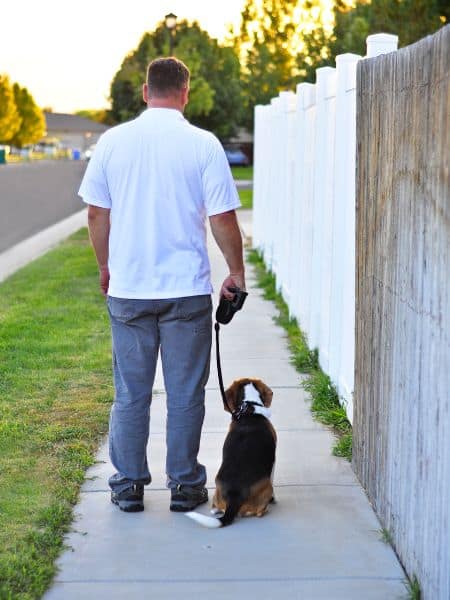Mastering the Art of Walking: A Comprehensive Guide to Leash Training Your Beagle
Leash training is one of the crucial skills every dog owner should teach their furry friend. Not only does it make walks more enjoyable, but it also ensures the safety of both the dog and its owner.
A dog that pulls on a leash can drag its owner into dangerous situations, putting both themselves and others at risk.
Additionally, an untrained dog can be difficult to control in public spaces like parks or sidewalks. It’s a potential threat to other people and animals.
In this blog post, we will explore some effective techniques for how to train a beagle not to pull on leash. It will help you have a more enjoyable and stress-free walk with your beagle.
Understanding Beagle Behavior

Beagles are known for their playful and energetic personalities, which can make leash training a challenge. But, by understanding why they pull on the leash, you can take steps to correct this behavior.
Explanation of Why Beagles Pull on Leash
In nature, beagles were bred as hunting dogs with a keen sense of smell. This means that when they are out on a walk or exploring their surroundings. they will want to follow every scent that they come across.
As a result, beagles have a natural tendency to pull on the leash. because they want to follow their nose and explore their environment.
Discussion of How Their Strong Sense of Smell and High Energy Levels Contribute to This Behavior
Beagles are active dogs with enough energy. This energy can translate into increased excitement and exuberance when out for walks or playtime outdoors.
Unfortunately, this means that some beagles. who haven’t been taught may forget their habits and pull hard on the leash to get more freedom.
When it comes to following scents, their strong sense of smell is also a big part of why they pull. Beagles have very strong noses, much stronger than ours. Even the tiniest smell makes them want to find out what it is.
All these things make it very important for people who own beagles to know how to train a beagle not to pull on leash. Not just for behavior but also for safety when they go for walks together.
Equipment Needed for Leash Training
Introduction to different types of collars and harnesses
Choosing the right equipment is an important part of leash training your beagle. Collars and harnesses are the most commonly used equipment for leash training.
Your chosen type will depend on your dog’s size, strength, and behavior. For beagles, a flat collar or a front-clip harness is recommended.
A flat collar is a simple collar made of nylon or leather that attaches to the leash at the back of the dog’s neck. A front-clip harness has a ring in front of the dog’s chest, which helps redirect their attention away from pulling.
Explanation of which types work best for beagles
A flat collar can work well for beagles who don’t pull too much on their leash. But, if your beagle tends to pull on a leash, a front-clip harness is a better option as it provides more control over their movements.
The front-clip design helps prevent pulling by redirecting the dog’s attention toward you when they try to pull forward. It also reduces pressure on their neck and spine compared to traditional collars that attach to the back of their necks.
Overall, choosing equipment that fits well and feels comfortable for your beagle is important. It would help if you always supervised your dog while they are wearing equipment and make adjustments as necessary for proper fit over time.
Remember that no matter what equipment you use. Consistent training techniques are crucial in teaching your beagle not to pull on a leash!
Basic Leash Training Techniques
The Importance of Positive Reinforcement
When training your beagle not to pull on a leash, positive reinforcement is key. Punishing your dog for pulling can make the behavior worse. as dogs often do not understand the connection between punishment and their actions.
Instead, focus on rewarding your beagle when they walk calmly beside you. This can include treats, verbal praise, or even a favorite toy.
Step-by-Step Instructions how to train a beagle not to pull on leash
- 1Start with short walks in a low-distraction environment.
- Keep the leash loose and wait until your beagle walks calmly beside you before rewarding them.
- If your beagle starts to pull, stop walking and don’t move until they calm down.
- When your beagle returns to walking calmly beside you, reward them.
- Gradually increase the length of your walks and introduce more distractions. as your dog gets better at walking without pulling.
Tips for Consistency in Training and Patience with Your Dog
Consistency is key in leash training. make sure everyone who walks your dog follows the same rules . and uses the same techniques for rewarding good behavior and correcting bad behavior.
It’s also important to remember that leash training takes time. some dogs may take weeks or even months to learn to avoid pulling on the leash consistently.
Stay patient with your dog and celebrate small victories. every step towards calm leash walking is progress!
Advanced Leash Training Techniques
Changing Directions – The Twist and Turn Method

If your beagle is still pulling on the leash, then it’s time to try out some advanced techniques. One of the most effective methods is the twist-and-turn method.
This involves changing directions every time your dog pulls on the leash. It confuses the dog and makes them unsure about where to go next.
To execute this technique, walk in one direction until your dog starts to pull. Then turn around in the opposite direction. Repeat this process until your beagle understands that pulling on the leash won’t get them where they want to go.
Stop-and-Go Technique
Another effective technique for leash training is known as stop-and-go. This method involves walking with your beagle and stopping every time they start to pull on their leash.
Waiting for them to settle down before moving forward again. Now sends a message that you won’t move. unless they’re calm or have relaxed the tension of their leash. so you can avoid getting jerked around by your furry friend during walks.
Tips for Success with Advanced Leash Training Techniques
When using advanced techniques like stop-and-go or changing directions. it’s important to make sure you have a good grasp of basic obedience commands like sit, stay, and heel. otherwise, these methods will not work effectively .
because there needs to be clear communication between owner and pet at all times while using these techniques. Be patient when trying out these methods, as it may take several tries before they start taking effect, but consistency is key.
Use a firm tone when giving commands so that your dog understands what behavior you expect from them. this will help build trust between owner and pet over time, making their walks more enjoyable for both of you!
Common Mistakes in Leash Training Beagles
Not Starting Early Enough
One of the most common mistakes owners make when leash training their beagle is waiting too long to start.
Beagles are highly energetic and curious dogs, and they can quickly develop bad habits if they are not properly trained from an early age.
As soon as you bring your beagle home. start introducing them to a collar or harness and a leash so that they can get used to being restrained.
Using Punishment-based Techniques
Another common mistake is using punishment-based techniques to try and train your beagle not to pull on a leash.
This can include yanking on the leash, shouting at your dog, or even physical punishment.
These techniques don’t work and can harm your relationship with your dog in the long run. Positive reinforcement techniques are more effective and gentle on your dog’s psyche.
Not Being Consistent
Consistency is key when it comes to training any dog, including beagles. One of the biggest mistakes owners make is not consistently applying training techniques. And allowing their dog to misbehave sometimes while expecting good behavior other times.
This needs to be clarified for the dog and make it much harder for them to understand what you expect from them on walks.
Lack of Patience
Training a beagle not to pull on a leash takes time, patience, and consistency. Many owners expect quick results within a few days or weeks.
But need to remember that every dog learns at its own pace. Lack of patience with inconsistent results only stresses you and your furry friend.
Conclusion
The Importance of Leash Training
Leash training is an essential part of being a responsible pet owner. Not only does it prevent your beagle from pulling you down the street. but it also keeps them safe from potential dangers like traffic or aggressive dogs.
By investing time and effort into leash training, you can ensure that your beagle will be a well-behaved and happy companion for years.
Persistence Pays Off
Training any dog takes patience and persistence, and beagles are no exception. While some dogs may catch on , others may need weeks or even months of training. Don’t get discouraged if progress seems slow at first. keep working with your dog, and , they will get it.
A Lifetime of Joyful Walks Awaits You
When you finally see your beagle walking calmly by your side on a loose leash, it feels like no other. You’ll enjoy many happy walks together without the frustration of being dragged down the street. And don’t forget walking is a great exercise for you and your dog! So put in the time now to teach proper leash manners, and you’ll reap the benefits for years.



